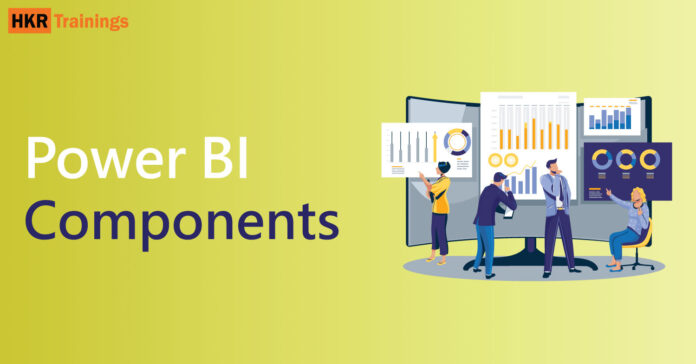Microsoft Power BI is a very popular Business Intelligence tool utilized for data analysis by analysts. Additionally, many businesses have embraced this top BI tool to handle their data efficiently and at a low cost and make informed decisions at the appropriate time. You can also hire a consulting firm to help your business in learning how to use it properly. You can click here for more information Power BI comprises 13 significant components that can be utilized in conjunction and make the data more organized and easier to understand. So, let’s get into the most well-known Components in Power BI.
A list of Microsoft Power BI Components
Power BI has its own set of building blocks for users in the business sector, commonly called Power BI content. Here are the components:
you can learn more about Power BI Interview Questions to get more information and knowledge.
What are the building blocks of Power BI?
Power BI consists of 5 principal tools that form the foundation for the functionality of Power BI, and they are:
- DataSets
The Dataflow source data or the set of imported data are referred to as Datasets. Each of these data sets is connected with Power BI to make them available in one location.
- Visualization
When the data are represented in charts/graphs/diagrams/ any other form of visuals, it is called visualization. They aid in reforming the data to make it easier to understand.
- Reports
Visual representations of information are called Reports and can include graphs, charts, maps, and treemaps. Reports can be made using Power BI and shared via dashboards or with your acquaintances. Another method of creating reports is to connect to different datasets using their SaaS applications or Excel workbooks. Reporting is made in two ways are called Reading View and Editing View. Besides, you can also use Power BI reporting services to get insights of data.
- Dashboards
A single sheet comprised of many tiles and widgets is known as Dashboards. They can be created by the user themselves or borrowed from one they created and shared with their friend within the Power BI service. It is an amalgamation of different reports and data.
- Tiles
Every single visual element stored in dashboards is known as a Tile. The Dashboard is an assortment of Tiles.
What are the main components of Power BI?
Power BI has a clearly defined structure containing various essential components that support the use. However, these components may also be utilized in various ways as necessary.
Power BI components include:
Component #1 – Power BI Desktop
The Power BI component is the initial and foremost component of the Power BI architecture. This is no-cost software that users can connect to different data sources, obtain data, transform it, and look at the data transformed on their desktops. It is also possible to create images and graphics that can be shared with the company. This element is considered the principal component and is widely used. If you consider yourself a newbie in using Power BI Desktop, consider taking Power BI Course to enhance your skills.
Component #2 Data Sources
Data Sources in Power BI are data gathered either by import or setting up a live service to retrieve the data. In both cases, the received data are only compressed versions since the storage capacity within Power BI is constrained. But, Power BI supports only specific sources of data that include:
- Online Services such as SharePoint Online List Power BI Service, Microsoft Exchange Online, Dynamics 365 (online), Salesforce reports, etc.
- Databases consisting of SQL Server Analysis Services, Sybase, Google BidQuery, Snowflake, Oracle, Access, and many others.
- File Types such as JSON, XML, Excel TXT/CSV, and many more. Share type point files All of them are supported by Power BI.
- Components of Azure such as Azure SQL Database Azure Table Storage, Azure Analysis Services Database (Beta), and many others are all accepted as valid by Power BI.
Component #3 Power BI Service
This is an essential service since it’s the online platform to transform the data, and reports are released and shared in Power BI Desktop. It is a service that adheres to the On-Cloud protocol services and the web-based platform. Utilizing Power BI Service, one can also build dashboards with different titles to Power BI Service like Power BI Web Portal, Power BI Suite, and Power BI Workspace. Beyond these features, it also assists users by offering natural language Q&A and notifications for updates and updated versions. Users can use Power BI Services in the Pro, Free, or Premium versions.
Component #4 Power BI Gateway
This is important because these gateways allow users to connect to their on-site sources of data without having to transfer data in the most secure way. Through these gateways, users can transfer data to On-premise applications and add directly to Microsoft Cloud Services like Power BI, PowerApps, Azure Logic Apps, Microsoft Flow, and others.
Component #5 Power BI Report Server
Anyone with a Power BI Premium license can make the most of the Power BI Report Server which lets them transfer reports as well as dashboards, data, and reports in the safest way inside and outside of the company.
Component 6 Power BI embedded.
This component is available only in Azure’s On-premises service. The purpose of this feature is the provision of APIs that users can use to embed their dashboards and reports integrated within their customized applications.
Component #7 PowerBI Mobile Apps
This allows users to access the data via their mobile devices. Power BI is compatible with Android, iOS, and Windows.
Component #8 Power BI Query
This feature increases data connectivity, allowing users to take and modify the data across different platforms and data sources to meet the requirements of their company. SDK connects that permits even its third connectors to build the data connector they want to use. It is the connector Power BI Query uses for its job.
Component #9 Power Pivot
It can be accessed via the Excel Workbook and can be used to develop a data model. It is used as a storage area where data can be stored after compression to the highest. The stored data can then be measured and aggregated and may be loaded in Power Pivot either by itself or with Power Query. It is similar to SSAS SQL Server Analysis Services from the Tabular Model.
Component #10 Power View
The component utilizes the data model from Power Pivot to offer the drag-and-drop feature that allows users to develop diverse visualizations for Excel. Excel workbooks. These visualizations can also be interactive.
Component #11 Power Maps
Maps are created to show the differentiating features in the visual data. These differences are displayed by using shades and colors. Shades. In the end, Power Maps provide a Data Visualisation Tool with the features of a 3-D geospatial tool.
Component #12 Power Q&A
This feature allows customers to utilize their natural language to ask questions and get answers to their questions.
Component #13 Power BI.com Website
This site can be used as a host site or cloud storage to store collected data, accessible on the internet.
A wide range of users embraces PowerBI’s components because they can be used in isolation and together. The flexibility of the components improves its effectiveness and is also a benefit to users who require large and small-sized data processing and sharing.
The Power BI components in Excel:
- While Power Query is inserted in Excel 2016, it’s appropriate for use in Excel 2010 and Excel 2013 since the add-ins for Power Query, by default.
- In Excel 2010, Power Pivot is used as an add-in; however, it was added in Excel 2013. Power Pivot became an integrated feature in Excel.
- Power View is present only in Excel 2013 and is also an add-in.
- Power Map is available in Excel 2013 as an add-in. It is included in Excel 2016 as an essential tool that allows the function of “3D maps.
- Power Q&A functions without the aid of add-ons or installations and is built with the other models of Power BI.
Conclusion:
Power BI is a powerful and vital tool that allows users to collect, manage modifications, and share information through a cloud platform. Its components work together to provide various functions, enhancing the overall efficiency that Power BI offers. These components can be combined to improve their efficiency and capabilities. One example of this could be Power BI Desktop, a blend comprised of Power Pivot, Power Query, and Power View. If Power BI is a dominant tool for business, it is also a must that its Power BI Components are equally vital to its success as when combined, they form Power BI.











